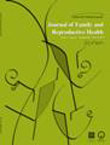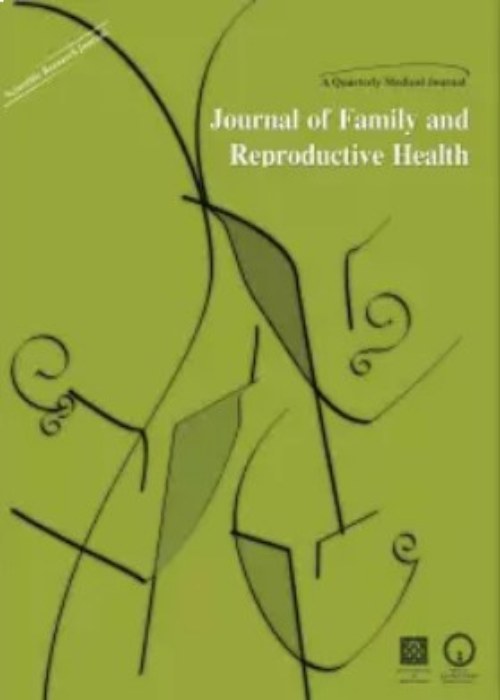فهرست مطالب

Journal of Family and Reproductive Health
Volume:8 Issue: 4, Dec 2014
- تاریخ انتشار: 1393/09/01
- تعداد عناوین: 8
-
-
Pages 135-148Osteoporosis is considered as an important public health problem especially in postmenopausal women. There are some hypotheses support the contributory effect of pregnancy and lactation on osteoporosis later in life. High calcium demand during pregnancy and lactation and low estrogenic state support those hypotheses. Numerous studies have investigated on the issue but there is no consensus about the contributory effect of pregnancy and lactation on osteoporosis. To explore the current state of fact, in the present study, all bibliographic databases were searched and all relevant studies on the topic of osteoporosis, lactation, and pregnancy were reviewed.The review shows that despite of controversial results, pregnancy may have protective effect on bone especially if followed by lactation.Keywords: bone loss, pregnancy, lactation, parity
-
Pages 149-153ObjectiveTo evaluate the impact of luteal phase support with vaginal progesterone on pregnancy rates in the intrauterine insemination (IUI) cycles, stimulated with clomiphene citrate and human menopausal gonadotropin (hMG), in sub fertile couples.Materials And MethodsThis prospective, randomized, double blind study was performed in a tertiary infertility center from March 2011 to January 2012. It consisted of 253 sub fertile couples undergoing ovarian stimulation for IUI cycles. They underwent ovarian stimulation with clomiphene citrate (100 mg) and hMG (75 IU) in preparation for the IUI cycle. Study group (n=127) received luteal phase support in the form of vaginal progesterone (400 mg twice a day), and control group (n=126) received placebo.Clinical pregnancy and abortion rates were assessed and compared between the two groups.ResultsThe clinical pregnancy rate was not significantly higher for supported cycles than that for the unsupported ones (15.75% vs. 12.69%, p=0.3). The abortion rate in the patients with progesterone luteal support compared to placebo group was not statistically different (10% vs. 18.75%, p=0.45).ConclusionIt seems that luteal phase support with vaginal progesterone was not enhanced the success of IUI cycles outcomes, when clomiphene citrate and hMG were used for ovulation stimulation.Keywords: clomiphene citrate, hMG, IUI, luteal phase support, progesterone
-
Pages 155-159ObjectiveTo determine the relationship between anthropometric indicators, physical activity (PA) and socioeconomic status (SES) with fundamental movement skills (FMS) among Iranian male students.Materials And MethodsIn this descriptive study, based on SES scores, 241 students (7-10 years) were randomly selected and classified in high, medium and low groups. All children were measured by 8 morphology anthropometric measures. In order to examine a subset of manipulative skills and to measure physical activity and socioeconomic status, Test of Gross Motor Development (TGMD2) and, interviewer-administered questionnaires were used, respectively. The data were analyzed using Pearson correlation and multiple regression.ResultsThere was a significant positive correlation between SES and body mass index (BMI), while a significant negative correlation existed between PA and BMI. Object control skills were significantly correlated with height, foot length, forearm length, hand length and physical activity.ConclusionStudents with low socioeconomic status were more qualified in movements than other students who were in medium and high socioeconomic status. Therefore, parents need to encourage students to be more active in order to prevent obesity and to facilitate development of object control skills in high socioeconomic status.Keywords: Elementary School Children, Anthropometry, Physical Activity, Socioeconomic status, Manipulative Skills
-
Pages 161-168ObjectiveTo assess and compare the nutritional status of children aged 5-14 years in arsenic exposed and non- exposed areas.Materials And MethodsIt was a cross sectional study conducted on 600 children of age 5-14 years from arsenic exposed and non-exposed areas in Bangladesh. Designed questionnaire and check list were used for collection of data. To estimate BMI necessary anthropometric measurements of the studied children were done. Dietary intakes of the study children were assessed using 24-hours recall method.ResultsThe difference of socio-economic conditions between the children of exposed area and non-exposed area was not significant. On an average the body mass index was found to be significantly (p < 0.01) lower among the children of arsenic exposed area (49%) in comparison to that of children in non-exposed area (38%). Stunting (p < 0.01), wasting (p < 0.05) and underweight (p< 0.05) were significantly higher in exposed group in comparison to non-exposed group. No significant difference of nutrition intake was found between exposed and non-exposed children as well as thin and normal children.ConclusionIn this study children exposed to arsenic contaminated water were found to be suffered from lower nutritional status.Keywords: Source of water, Arsenic level, Tube well water, Dietary intake, Height, Weight, Stool parasite
-
Pages 169-173ObjectiveTo determine the possible association between the M235T variant of angiotensinogen gene and preeclampsia in Iranian preeclamtic women with hypertension during pregnancy.Materials And MethodsDuring a case control study, we used polymerase chain reaction-based restriction fragment length polymorphism (PCR-RFLP) analysis to investigate the association between M235T polymorphism in preeclamtic women compared to normotensive controls.ResultsThe M235T polymorphism was significantly associated with increasedpreeclampsia risk in the studied population as supported by a p value of 0.017 and chi-square value of 8.12. The frequency of mutated allele and genotype distribution showed a significant difference between preeclamtic women and control groups.ConclusionThe result indicates that the AGT M235T polymorphism playsa significant role in preeclampsia observed in selected Iranian preeclamtic women, and it can be considered as a major risk factor for preeclampsia.Keywords: Angiotensinogen M235T Polymorphism, Preeclampsia
-
Pages 175-181ObjectiveTo find out the quality of ANC in the Upazila Health Complexes (PHC centres) of Bangladesh.Materials And MethodsThis cross sectional study was done in purposively selected three upazilas among the clients receiving antenatal care (ANC). Data were collected with questionnaire cum checklist in the context of two aspects of quality issues, namely assessment of physical arrangements for ANC (input) and services rendered by the providers (process).ResultsThe mean age of respondents was 24.6±4.5 years. Majority of the respondents were with primary level education (60.3%). About half (52.8%) of the families had monthly income ranging from 3000-5000 taka (38-64 US$). Nearly half (48.9%) had no child, little more than one third (42.3%) were primigravida and 528 (57.7%) were multigravida. Out of 528 multigravid respondents 360 (68.2%) took ANC in their previous pregnancy whereas 168 (31.8%) did not take ANC Pregnancy outcome was found to be associated with receiving ANC (χ2=73.599; p=0.000). Respondents receiving ANC had more good pregnancy outcome. The mean waiting time for receiving ANC was 0.77±.49 hours. Out of the 13 centers, only 3 (23.1%) have sufficient instruments to render ANC services. Findings showed that where the modes of ANC service delivery in the ANC centers are fairly satisfactory. Though some of the points of standard operation procedures (SOPs) on ANC are not covered by some ANC centers, those were not considered necessary. But, regarding the physical facilities available for rendering ANC services, it is seen that facilities are not quite satisfactory. Number of doctors and nurses are not very satisfactory. One of the centers under this study has no doctor, where ANC services are given by nurses.ConclusionIt can be concluded that the ANC services at the primary health care level is not adequate in Bangladesh. To ensure further improvement of the quality of ANC services, instruments used in logistics and supplies should be enhanced.Keywords: Antenatal Care, Primigravida, Multigravida, Primary Health Care
-
Pages 183-188ObjectiveTo understand the knowledge and services of informal providers and to explore their role in addressing the human resource gap in Uttar Pradesh, India, within the context of maternal health.Materials And MethodsThe study is exploratory in nature, conducted in four blocks of four districts of Uttar Pradesh state, India. Semi-structured interviews were conducted with 114 informal providers.ResultsMore than one-third (38%) providers have some formal education and unrecognized degrees. Approximately three-fourths (74%) of them have more than 5 years of work experience. They also provide delivery and in-patient services and have basic equipment available. However, they lack essential knowledge about maternal health. They have mixed opinion about their contribution towards maternal health but the only ones available. Therefore, despite lacking requisite knowledge, training and services, they become indispensable due to lack of emergency and timely public health services, and being the only ones existing in the community.ConclusionInformal sector practitioners are a critical link in reaching out to population for health services in developing countries. As opposed to the general notion, they possess years of formal education, experience, informal trainings along with trust of communities. Thus, it becomes important to accept their presence and manage them to the best of their abilities even for specialized care like maternal health.Keywords: Maternal Healthcare, Informal Providers, Health Human Resources, India
-
Pages 189-193ObjectiveAlthough numerous studies have found higher rates ofabortion and still births following consanguinity (familial marriages), the question of whether consanguinity significantly increases the risk of neonatal death has inadequately been addressed.This study aims to evaluate familial marriage effects on neonatal death in rural areas in Iran.Materials And MethodsIn this nested case-control study, 6900 newbornswho were born in rural areas of Kohgiluyeh and Boyerahmad Province (South-West of Iran)were followed till the end of neonatal period, and neonatal death was the outcome of interest. Subsequently 97 cases and 97 controls were selected in study cohort by using risk set sampling model. Crude and adjusted odds ratios (OR) were estimated by usinga conditional logistic regression model.ResultsIn the final model, prematurity (OR = 5.57), low birthweight (LBW) (OR = 7.68), consanguinity (first cousins) (OR = 5.23), C-section (OR = 7.27), birth rank more than 3 (OR = 6.95) and birthsinterval less than 24 months (OR=4.65) showed significant statistical association with neonatal mortality (p < 0.05).ConclusionAccording to our findings, after adjusting the effects of other significant risk factors, familial marriageto first cousins is considered asan important risk factor for neonatal death.Keywords: Neonatal Death, Nested Case, Control Study, Consanguinity, Rural Areas, Iran


